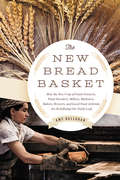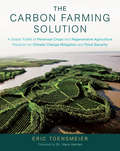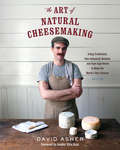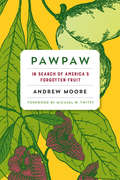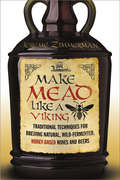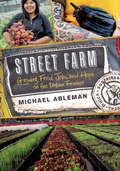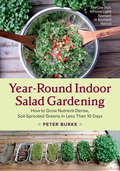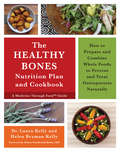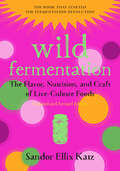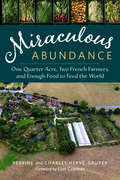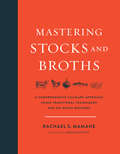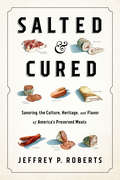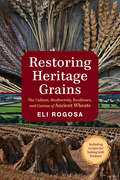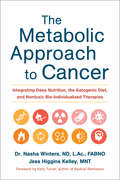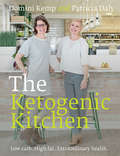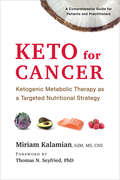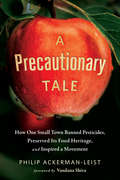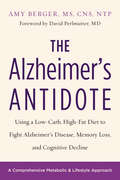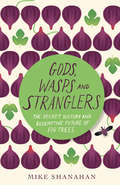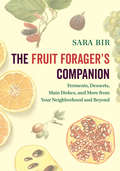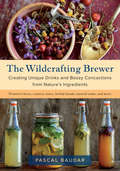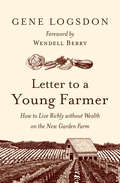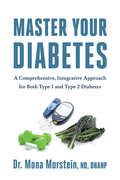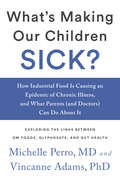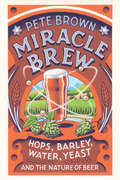- Table View
- List View
The New Bread Basket: How the New Crop of Grain Growers, Plant Breeders, Millers, Maltsters, Bakers, Brewers, and Local Food Activists Are Redefining Our Daily Loaf
by Amy HalloranFor more than 10,000 years, grains have been the staples of Western civilization. The stored energy of grain allowed our ancestors to shift from nomadic hunting and gathering and build settled communities—even great cities. Though most bread now comes from factory bakeries, the symbolism of wheat and bread—amber waves of grain, the staff of life—still carries great meaning. Today, bread and beer are once again building community as a new band of farmers, bakers, millers, and maltsters work to reinvent local grain systems. The New Bread Basket tells their stories and reveals the village that stands behind every loaf and every pint. While eating locally grown crops like heirloom tomatoes has become almost a cliché, grains are late in arriving to local tables, because growing them requires a lot of land and equipment. Milling, malting, and marketing take both tools and cooperation. The New Bread Basket reveals the bones of that cooperation, profiling the seed breeders, agronomists, and grassroots food activists who are collaborating with farmers, millers, bakers, and other local producers. Take Andrea and Christian Stanley, a couple who taught themselves the craft of malting and opened the first malthouse in New England in one hundred years. Outside Ithaca, New York, bread from a farmer-miller-baker partnership has become an emblem in the battle against shale gas fracking. And in the Pacific Northwest, people are shifting grain markets from commodity exports to regional feed, food, and alcohol production. Such pioneering grain projects give consumers an alternative to industrial bread and beer, and return their production to a scale that respects people, local communities, and the health of the environment. Many Americans today avoid gluten and carbohydrates. Yet, our shared history with grains—from the village baker to Wonder Bread—suggests that modern changes in farming and processing could be the real reason that grains have become suspect in popular nutrition. The people profiled in The New Bread Basket are returning to traditional methods like long sourdough fermentations that might address the dietary ills attributed to wheat. Their work and lives make our foundational crops visible, and vital, again.
The Carbon Farming Solution: A Global Toolkit of Perennial Crops and Regenerative Agriculture Practices for Climate Change Mitigation and Food Security
by Eric Toensmeier Dr Hans HerrenWith carbon farming, agriculture ceases to be part of the climate problem and becomes a critical part of the solution Agriculture is rightly blamed as a major culprit of our climate crisis. But in this groundbreaking new book, Eric Toensmeier argues that agriculture—specifically, the subset of practices known as “carbon farming”—can, and should be, a linchpin of a global climate solutions platform. Carbon farming is a suite of agricultural practices and crops that sequester carbon in the soil and in above-ground biomass. Combined with a massive reduction in fossil fuel emissions—and in concert with adaptation strategies to our changing environment— carbon farming has the potential to bring us back from the brink of disaster and return our atmosphere to the “magic number” of 350 parts per million of carbon dioxide. Toensmeier’s book is the first to bring together these powerful strategies in one place, including in-depth analysis of the available research and, where research is lacking, a discussion of what it will take to get us there. Carbon farming can take many forms. The simplest practices involve modifications to annual crop production. Although many of these modifications have relatively low sequestration potential, they are widely applicable and easily adopted, and thus have excellent potential to mitigate climate change if practiced on a global scale. Likewise, grazing systems such as silvopasture are easily replicable, don’t require significant changes to human diet, and—given the amount of agricultural land worldwide that is devoted to pasture—can be important strategies in the carbon farming arsenal. But by far, agroforestry practices and perennial crops present the best opportunities for sequestration. While many of these systems are challenging to establish and manage, and would require us to change our diets to new and largely unfamiliar perennial crops, they also offer huge potential that has been almost entirely ignored by climate crusaders. Many of these carbon farming practices are already implemented globally on a scale of millions of hectares. These are not minor or marginal efforts, but win-win solutions that provide food, fodder, and feedstocks while fostering community self-reliance, creating jobs, protecting biodiversity, and repairing degraded land—all while sequestering carbon, reducing emissions, and ultimately contributing to a climate that will remain amenable to human civilization. Just as importantly to a livable future, these crops and practices can contribute to broader social goals such as women’s empowerment, food sovereignty, and climate justice. The Carbon Farming Solution does not present a prescription for how cropland should be used and is not, first and foremost, a how-to manual, although following up on references in a given section will frequently provide such information. Instead, The Carbon Farming Solution is—at its root—a toolkit. It is the most complete collection of climate-friendly crops and practices currently available. With this toolkit, farmers, communities, and governments large and small, can successfully launch carbon farming projects with the most appropriate crops and practices to their climate, locale, and socioeconomic needs. Toensmeier’s ultimate goal is to place carbon farming firmly in the center of the climate solutions platform, alongside clean solar and wind energy. With The Carbon Farming Solution, Toensmeier wants to change the discussion, impact policy decisions, and steer mitigation funds to the research, projects, and people around the world who envision a future where agriculture becomes the protagonist in this fraught, urgent, and unprecedented drama of our time. Citizens, farmers, and funders will be inspired to use the tools presented in this important new book to transform degraded lands around the world into productive carbon-storing landscapes.
The Art of Natural Cheesemaking: Using Traditional, Non-Industrial Methods and Raw Ingredients to Make the World's Best Cheeses
by David Asher Sandor Ellix KatzIncluding more than 35 step-by-step recipes from the Black Sheep School of Cheesemaking Most DIY cheesemaking books are hard to follow, complicated, and confusing, and call for the use of packaged freeze-dried cultures, chemical additives, and expensive cheesemaking equipment. For though bread baking has its sourdough, brewing its lambic ales, and pickling its wild fermentation, standard Western cheesemaking practice today is decidedly unnatural. In The Art of Natural Cheesemaking, David Asher practices and preaches a traditional, but increasingly countercultural, way of making cheese—one that is natural and intuitive, grounded in ecological principles and biological science. This book encourages home and small-scale commercial cheesemakers to take a different approach by showing them: • How to source good milk, including raw milk; • How to keep their own bacterial starter cultures and fungal ripening cultures; • How make their own rennet—and how to make good cheese without it; • How to avoid the use of plastic equipment and chemical additives; and • How to use appropriate technologies. Introductory chapters explore and explain the basic elements of cheese: milk, cultures, rennet, salt, tools, and the cheese cave. The fourteen chapters that follow each examine a particular class of cheese, from kefir and paneer to washed-rind and alpine styles, offering specific recipes and handling advice. The techniques presented are direct and thorough, fully illustrated with hand-drawn diagrams and triptych photos that show the transformation of cheeses in a comparative and dynamic fashion. The Art of Natural Cheesemaking is the first cheesemaking book to take a political stance against Big Dairy and to criticize both standard industrial and artisanal cheesemaking practices. It promotes the use of ethical animal rennet and protests the use of laboratory-grown freeze-dried cultures. It also explores how GMO technology is creeping into our cheese and the steps we can take to stop it. This book sounds a clarion call to cheesemakers to adopt more natural, sustainable practices. It may well change the way we look at cheese, and how we make it ourselves.
Pawpaw: In Search of America’s Forgotten Fruit
by Andrew Moore Michael W. TwittyThe largest edible fruit native to the United States tastes like a cross between a banana and a mango. It grows wild in twenty-six states, gracing Eastern forests each fall with sweet-smelling, tropical-flavored abundance. Historically, it fed and sustained Native Americans and European explorers, presidents, and enslaved African Americans, inspiring folk songs, poetry, and scores of place names from Georgia to Illinois. Its trees are an organic grower’s dream, requiring no pesticides or herbicides to thrive, and containing compounds that are among the most potent anticancer agents yet discovered. So why have so few people heard of the pawpaw, much less tasted one? In Pawpaw—a 2016 James Beard Foundation Award nominee in the Writing & Literature category—author Andrew Moore explores the past, present, and future of this unique fruit, traveling from the Ozarks to Monticello; canoeing the lower Mississippi in search of wild fruit; drinking pawpaw beer in Durham, North Carolina; tracking down lost cultivars in Appalachian hollers; and helping out during harvest season in a Maryland orchard. Along the way, he gathers pawpaw lore and knowledge not only from the plant breeders and horticulturists working to bring pawpaws into the mainstream (including Neal Peterson, known in pawpaw circles as the fruit’s own “Johnny Pawpawseed”), but also regular folks who remember eating them in the woods as kids, but haven’t had one in over fifty years. As much as Pawpaw is a compendium of pawpaw knowledge, it also plumbs deeper questions about American foodways—how economic, biologic, and cultural forces combine, leading us to eat what we eat, and sometimes to ignore the incredible, delicious food growing all around us. If you haven’t yet eaten a pawpaw, this book won’t let you rest until you do.
Make Mead Like a Viking: Traditional Techniques for Brewing Natural, Wild-Fermented, Honey-Based Wines and Beers
by Jereme ZimmermanA complete guide to using the best ingredients and minimal equipment to create fun and flavorful brews Ancient societies brewed flavorful and healing meads, ales, and wines for millennia using only intuition, storytelling, and knowledge passed down through generations—no fancy, expensive equipment or degrees in chemistry needed. In Make Mead Like a Viking, homesteader, fermentation enthusiast, and self-described “Appalachian Yeti Viking” Jereme Zimmerman summons the bryggjemann of the ancient Norse to demonstrate how homebrewing mead—arguably the world’s oldest fermented alcoholic beverage—can be not only uncomplicated but fun. Armed with wild-yeast-bearing totem sticks, readers will learn techniques for brewing sweet, semi-sweet, and dry meads, melomels (fruit meads), metheglins (spiced meads), Ethiopian t’ej, flower and herbal meads, braggots, honey beers, country wines, and even Viking grog, opening the Mead Hall doors to further experimentation in fermentation and flavor. In addition, aspiring Vikings will explore: • The importance of local and unpasteurized honey for both flavor and health benefits; • Why modern homebrewing practices, materials, and chemicals work but aren’t necessary; • How to grow and harvest herbs and collect wild botanicals for use in healing, nutritious, and magical meads, beers, and wines; • Hops’ recent monopoly as a primary brewing ingredient and how to use botanicals other than hops for flavoring and preserving mead, ancient ales, and gruits; • The rituals, mysticism, and communion with nature that were integral components of ancient brewing and can be for modern homebrewers, as well; • Recommendations for starting a mead circle to share your wild meads with other brewers as part of the growing mead-movement subculture; and more! Whether you’ve been intimidated by modern homebrewing’s cost or seeming complexity in the past—and its focus on the use of unnatural chemicals—or are boldly looking to expand your current brewing and fermentation practices, Zimmerman’s welcoming style and spirit will usher you into exciting new territory. Grounded in history and mythology, but—like Odin’s ever-seeking eye—focusing continually on the future of self-sufficient food culture, Make Mead Like a Viking is a practical and entertaining guide for the ages.
Street Farm: Growing Food, Jobs, and Hope on the Urban Frontier
by Michael AblemanStreet Farm is the inspirational account of residents in the notorious Low Track in Vancouver, British Columbia—one of the worst urban slums in North America—who joined together to create an urban farm as a means of addressing the chronic problems in their neighborhood. It is a story of recovery, of land and food, of people, and of the power of farming and nourishing others as a way to heal our world and ourselves. During the past seven years, Sole Food Street Farms—now North America’s largest urban farm project—has transformed acres of vacant and contaminated urban land into street farms that grow artisan-quality fruits and vegetables. By providing jobs, agricultural training, and inclusion in a community of farmers and food lovers, the Sole Food project has empowered dozens of individuals with limited resources who are managing addiction and chronic mental health problems. Sole Food’s mission is to encourage small farms in every urban neighborhood so that good food can be accessible to all, and to do so in a manner that allows everyone to participate in the process. In Street Farm, author-photographer-farmer Michael Ableman chronicles the challenges, growth, and success of this groundbreaking project and presents compelling portraits of the neighborhood residents-turned-farmers whose lives have been touched by it. Throughout, he also weaves his philosophy and insights about food and farming, as well as the fundamentals that are the underpinnings of success for both rural farms and urban farms. Street Farm will inspire individuals and communities everywhere by providing a clear vision for combining innovative farming methods with concrete social goals, all of which aim to create healthier and more resilient communities.
Year-Round Indoor Salad Gardening: How to Grow Nutrient-Dense, Soil-Sprouted Greens in Less Than 10 days
by Peter BurkeThe Low-Tech, No-Grow-Lights Approach to Abundant Harvest Year-Round Indoor Salad Gardening offers good news: with nothing more than a cupboard and a windowsill, you can grow all the fresh salad greens you need for the winter months (or throughout the entire year) with no lights, no pumps, and no greenhouse. Longtime gardener Peter Burke was tired of the growing season ending with the first frost, but due to his busy work schedule and family life, didn’t have the time or interest in high-input grow lights or greenhouses. Most techniques for growing what are commonly referred to as “microgreens” left him feeling overwhelmed and uninterested. There had to be a simpler way to grow greens for his family indoors. After some research and diligent experimenting, Burke discovered he was right—there was a way! And it was even easier than he ever could have hoped, and the greens more nutrient packed. He didn’t even need a south-facing window, and he already had most of the needed supplies just sitting in his pantry. The result: healthy, homegrown salad greens at a fraction of the cost of buying them at the market. The secret: start them in the dark. Growing “Soil Sprouts”—Burke’s own descriptive term for sprouted seeds grown in soil as opposed to in jars—employs a method that encourages a long stem without expansive roots, and provides delicious salad greens in just seven to ten days, way earlier than any other method, with much less work. Indeed, of all the ways to grow immature greens, this is the easiest and most productive technique. Forget about grow lights and heat lamps! This book is a revolutionary and inviting guide for both first-time and experienced gardeners in rural or urban environments. All you need is a windowsill or two. In fact, Burke has grown up to six pounds of greens per day using just the windowsills in his kitchen! Year-Round Indoor Salad Gardening offers detailed step-by-step instructions to mastering this method (hint: it’s impossible not to succeed, it’s so easy!), tools and accessories to have on hand, seeds and greens varieties, soil and compost, trays and planters, shelving, harvest and storage, recipes, scaling up to serve local markets, and much more.
The Healthy Bones Nutrition Plan and Cookbook: How to Prepare and Combine Whole Foods to Prevent and Treat Osteoporosis Naturally
by Dr Laura Kelly Helen Bryman Kelly Dr Sidney MacDonald BakerA Medicine Through Food™ Guide Drugs that claim to prevent or redress bone loss can actually cause bones to crumble and break. Calcium supplements, fortified processed food, and pasteurized dairy don't work because the calcium in them doesn't reach our bones. It’s a grim picture, but The Healthy Bones Nutrition Plan and Cookbook can help. Coauthors Dr. Laura Kelly and Helen Bryman Kelly, daughter and mother, have a firm grasp on the disciplines concerned with bone health, including nutrient absorption and bone metabolism. They offer readers a natural, effective, and safe approach to conserving bone mass and building healthy bones by creating a personalized nutrition plan that includes eating the right foods in the right combinations. The authors’ quest for a natural, effective, safe way to prevent and treat bone loss began after 20 years of frustration, during which Helen tried supplements and several popular dietary approaches to arrest bone loss, only to see her bones continue to deteriorate year by year. Drawing on her knowledge of metabolic science and a rigorous examination of current research, Laura created a unique diet-based approach to bone health that allowed Helen’s body to absorb the nutrients that are naturally present in whole foods. Helen has been following her personal nutrition plan for four years and has stopped her bone loss completely—without taking any pharmaceuticals. Part One of the book begins with a primer on bone metabolism, including the roles of individual vitamins, minerals, and enzymes that can help build strong bones. Building on this knowledge and more, the authors provide a framework and worksheets so readers can use the recipes and work with their doctors to create their personal nutrition plan for skeletal health. The book includes more than 100 bone-health recipes ranging from sauces and small plates to soups, salads, and main dishes, drinks and desserts. The authors also explain how to make staple ingredients such as ghee and bone health vinegar and how to grow shiitake mushrooms—an important source of vitamin D. Readers can count on their personal nutrition plans and the Kellys’ recipes to provide food that helps calcium reach, and potentially strengthen, their bones.
Wild Fermentation: The Flavor, Nutrition, and Craft of Live-Culture Foods, 2nd Edition
by Sandor Ellix Katz Sally Fallon MorellThe Book That Started the Fermentation Revolution Sandor Ellix Katz, winner of a James Beard Award and New York Times bestselling author, whom Michael Pollan calls the “Johnny Appleseed of Fermentation” returns to the iconic book that started it all, but with a fresh perspective, renewed enthusiasm, and expanded wisdom from his travels around the world. This self-described fermentation revivalist is perhaps best known simply as Sandorkraut, which describes his joyful and demystifying approach to making and eating fermented foods, the health benefits of which have helped launch a nutrition-based food revolution. Since its publication in 2003, and aided by Katz’s engaging and fervent workshop presentations, Wild Fermentation has inspired people to turn their kitchens into food labs: fermenting vegetables into sauerkraut, milk into cheese or yogurt, grains into sourdough bread, and much more. In turn, they’ve traded batches, shared recipes, and joined thousands of others on a journey of creating healthy food for themselves, their families, and their communities. Katz’s work earned him the Craig Clairborne lifetime achievement award from the Southern Foodways Alliance, and has been called “one of the unlikely rock stars of the American food scene” by The New York Times. This updated and revised edition, now with full color photos throughout, is sure to introduce a whole new generation to the flavors and health benefits of fermented foods. It features many brand-new recipes—including Strawberry Kvass, African Sorghum Beer, and Infinite Buckwheat Bread—and updates and refines original recipes reflecting the author’s ever-deepening knowledge of global food traditions that has influenced four-star chefs and home cooks alike. For Katz, his gateway to fermentation was sauerkraut. So open this book to find yours, and start a little food revolution right in your own kitchen. Praise for Sandor Ellix Katz and his books: “The Art of Fermentation is an extraordinary book, and an impressive work of passion and scholarship.”—Deborah Madison, author of Local Flavors “Sandor Katz has proven himself to be the king of fermentation.”—Sally Fallon Morell, President, The Weston A. Price Foundation “Sandor Katz has already awakened more people to the diversity and deliciousness of fermented foods than any other single person has over the last century.”—Gary Paul Nabhan, author of Growing Food in a Hotter, Drier Land “The fermenting bible.” — Newsweek “In a country almost clinically obsessed with sterilization Katz reminds us of the forgotten benefits of living in harmony with our microbial relatives.” — Grist
Miraculous Abundance: One Quarter Acre, Two French Farmers, and Enough Food to Feed the World
by Perrine Hervé-Gruyer Charles Hervé-Gruyer Eliot ColemanThe Bec Hellouin model for growing food, sequestering carbon, creating jobs, and increasing biodiversity without using fossil fuels When Charles and Perrine Hervé-Gruyer set out to create their farm in an historic Normandy village, they had no idea just how much their lives would change. Neither one had ever farmed before. Charles had been circumnavigating the globe by sail, operating a floating school that taught students about ecology and indigenous cultures. Perrine had been an international lawyer in Japan. Each had returned to France to start a new life. Eventually, Perrine joined Charles in Normandy, and Le Ferme du Bec Hellouin was born. Bec Hellouin has since become a celebrated model of innovative, ecological agriculture in Europe, connected to national and international organizations addressing food security, heralded by celebrity chefs as well as the Slow Food movement, and featured in the inspiring César and COLCOA award-winning documentary film, Demain ("Tomorrow"). Miraculous Abundance is the eloquent tale of the couple’s evolution from creating a farm to sustain their family to delving into an experiment in how to grow the most food possible, in the most ecological way possible, and create a farm model that can carry us into a post-carbon future—when oil is no longer moving goods and services, energy is scarcer, and localization is a must. Today, the farm produces a variety of vegetables using a mix of permaculture, bio-intensive, four-season, and natural farming techniques--as well as techniques gleaned from native cultures around the world. It has some animals for eggs and milk, horses for farming, a welcome center, a farm store, a permaculture school, a bread oven for artisan breads, greenhouses, a cidery, and a forge. It has also become the site of research focusing on how small organic farms like theirs might confront Europe’s (and the world’s) projected food crisis. But in this honest and engaging account of the trials and joys of their uncompromising effort, readers meet two people who are farming the future as much as they are farming their land. They envision farms like theirs someday being the hub for a host of other businesses that can drive rural communities—from bread makers and grain millers to animal care givers and other tradespeople. Market farmers and home gardeners alike will find much in these pages, but so will those who’ve never picked up a hoe. The couple’s account of their quest to design an almost Edenlike farm, hone their practices, and find new ways to feed the world is an inspiring tale. It is also a love letter to a future in which people increasingly live in rural communities that rely on traditional skills, locally created and purveyed goods and services, renewable energy, and greater local governance, but are also connected to the larger world.
Mastering Stocks and Broths: A Comprehensive Culinary Approach Using Traditional Techniques and No-Waste Methods
by Rachael Mamane Adam Danforth2018 James Beard Foundation Book Award Finalist, "Single Subject" Category “Top Ten Cookbook of 2017”—Booklist Stocks and broths are the foundation of good cooking, yet information on their use is often relegated to the introductions or appendices of cookbooks. Until now there has not been a comprehensive culinary guide to stocks in the canon, save for snippets here and there. Hard to believe, since most passionate home cooks and professional chefs know that using stocks and broths—both on their own and as the base for a recipe—can turn a moderately flavorful dish into a masterpiece. Mastering Stocks and Broths is the comprehensive guide to culinary stocks and broths that passionate home cooks and innovative chefs have all been waiting for. Rachael Mamane, a self-taught cook and owner of small-scale broth company Brooklyn Bouillon, is reminiscent of M. F. K. Fisher, Patience Gray, and Julia Child. She takes us on a culinary journey into the science behind fundamental stocks and the truth about well-crafted bone broths, and offers over 100 complex and unique recipes incorporating stocks as foundational ingredients. Mastering Stocks and Broths includes a historical culinary narrative about stocks in the classic French technique as well as through the lens of other cultures around the world. Readers will learn about the importance of quality sourcing, the practical and health benefits of stocks and broths, and detailed methodology on how to develop, store, and use them in a home kitchen. The recipes place a playful emphasis on the value of zero waste, turning spent bones, produce seconds, and leftover animal fats into practical products to use around the home. Readers will turn to this book when they find themselves wondering what to do with the carcass of a store-bought roast chicken and they want to learn how to make every inch of their vegetables go further. Perhaps most important to remember: a good stock takes time. This is part of the pleasure—making stocks is meditative and meaningful, if you allow yourself the occasion. Building a stock often happens in the background of most kitchens—a smell that permeates a residence, a gentle warmth that radiates from the kitchen. Readers will be inspired by Mamane’s approach to truly slow cookery and her effervescent love for food itself.
Salted and Cured: Savoring the Culture, Heritage, and Flavor of America's Preserved Meats
by Jeffrey RobertsFrom country ham to coppa, bacon to bresaola Prosciutto. Andouille. Country ham. The extraordinary rise in popularity of cured meats in recent years often overlooks the fact that the ancient practice of meat preservation through the use of salt, time, and smoke began as a survival technique. All over the world, various cultures developed ways to extend the viability of the hunt—and later the harvest—according to their unique climates and environments, resulting in the astonishing diversity of preserved meats that we celebrate and enjoy today everywhere from corner delis to white-tablecloth restaurants. In Salted and Cured, author Jeffrey P. Roberts traces the origins of today’s American charcuterie, salumi, and other delights, and connects them to a current renaissance that begins to rival those of artisan cheese and craft beer. In doing so, Roberts highlights the incredible stories of immigrant butchers, breeders, chefs, entrepreneurs, and other craftspeople who withstood the modern era’s push for bland, industrial food to produce not only delicious but culturally significant cured meats. By rejecting the industry-led push for “the other white meat” and reinvigorating the breeding and production of heritage hog breeds while finding novel ways to utilize the entire animal—snout to tail—today’s charcutiers and salumieri not only produce everything from country ham to violino di capra but create more sustainable businesses for farmers and chefs. Weaving together agriculture, animal welfare and health, food safety and science, economics, history, a deep sense of place, and amazing preserved foods, Salted and Cured is a literary feast, a celebration of both innovation and time-honored knowledge, and an expertly guided tour of America’s culinary treasures, both old and new.
Restoring Heritage Grains: The Culture, Biodiversity, Resilience, and Cuisine of Ancient Wheats
by Eli RogosaIncluding recipes for baking with Einkorn Wheat is the most widely grown crop on our planet, yet industrial breeders have transformed this ancient staff of life into a commodity of yield and profit—witness the increase in gluten intolerance and 'wheat belly’. Modern wheat depends on synthetic fertilizer and herbicides that damage our health, land, water, and environment. Fortunately, heritage ‘landrace' wheats that evolved over millennia in the organic fields of traditional farms do not need bio-chemical intervention to yield bountifully, are gluten-safe, have rich flavor and high nutrition. Yet the robust, majestic wheats that nourished our ancestors are on the verge of extinction. In Restoring Heritage Grains, author Eli Rogosa of the Heritage Grain Conservancy, invites readers to restore forgotten wheats such as delicious gluten-safe einkorn that nourished the first Neolithic farmers, emmer—the grain of ancient Israel, Egypt, and Rome that is perfect for pasta and flatbreads, rare durums that are drought-tolerant and high in protein, and many more little known wheat species, each of which have a lineage intertwined with the human species and that taste better than any modern wheat. Restoring Heritage Grains combines the history of grain growing and society, in-depth practical advice on landrace wheat husbandry, wheat folk traditions and mythology, and guidelines for the Neolithic diet with traditional recipes for rustic bread, pastry and beer. Discover the ancient grains that may be one of the best solutions to hunger today, and provide resilience for our future.
The Metabolic Approach to Cancer: Integrating Deep Nutrition, the Ketogenic Diet, and Nontoxic Bio-Individualized Therapies
by Dr Nasha Winters Jess Higgins Kelley Kelly TurnerThe Optimal Terrain Ten Protocol to Reboot Cellular Health Since the beginning of the twentieth century, cancer rates have increased exponentially—now affecting almost 50 percent of the American population. Conventional treatment continues to rely on chemotherapy, surgery, and radiation to attack cancer cells. Yet research has repeatedly shown that 95 percent of cancer cases are directly linked to diet and lifestyle. The Metabolic Approach to Cancer is the book we have been waiting for—it offers an innovative, metabolic-focused nutrition protocol that actually works. Naturopathic, integrative oncologist and cancer survivor Dr. Nasha Winters and nutrition therapist Jess Higgins Kelley have identified the ten key elements of a person’s “terrain” (think of it as a topographical map of our body) that are crucial to preventing and managing cancer. Each of the terrain ten elements—including epigenetics, the microbiome, the immune system, toxin exposures, and blood sugar balance—is illuminated as it relates to the cancer process, then given a heavily researched and tested, non-toxic and metabolic, focused nutrition prescription. The metabolic theory of cancer—that cancer is fueled by high carbohydrate diets, not “bad” genetics—was introduced by Nobel Prize-laureate and scientist Otto Warburg in 1931. It has been largely disregarded by conventional oncology ever since. But this theory is resurging as a result of research showing incredible clinical outcomes when cancer cells are deprived of their primary fuel source (glucose). The ketogenic diet—which relies on the body’s production of ketones as fuel—is the centerpiece of The Metabolic Approach to Cancer. Further, Winters and Kelley explain how to harness the anticancer potential of phytonutrients abundant in low-glycemic plant and animal foods to address the 10 hallmarks of cancer—an approach Western medicine does with drug based therapies. Their optimized, genetically-tuned diet shuns grains, legumes, sugar, genetically modified foods, pesticides, and synthetic ingredients while emphasizing whole, wild, local, organic, fermented, heirloom, and low-glycemic foods and herbs. Other components of their approach include harm-reductive herbal therapies like mistletoe (considered the original immunotherapy and common in European cancer care centers) and cannabinoids (which shrink tumors and increase quality of life, yet are illegal in more than half of the United States). Through addressing the ten root causes of cancer and approaching the disease from a nutrition-focused standpoint, we can slow cancer’s endemic spread and live optimized lives.
The Ketogenic Kitchen: Low carb. High fat. Extraordinary health.
by Domini Kemp Patricia DalyCancer survivors Domini Kemp and Patricia Daly offer the first comprehensive ketogenic cookbook based on the most exciting new research on nutritional approaches to the prevention and management of cancer. For decades, the ketogenic diet—which shifts the body’s metabolism from burning glucose to burning fat, lowering blood sugar and insulin and resulting in a metabolic state known as ketosis—has been used to successfully manage pediatric epilepsy. More recently, it has been used by the Paleo community as a weight loss strategy. Now emerging research suggests that a ketogenic diet, in conjunction with conventional treatments, also offers new hope for those coping with cancer and other serious disease. With endorsements from leading researchers and oncologists such as Dr. Thomas Seyfried (Cancer as a Metabolic Disease), The Ketogenic Kitchen offers more than 250 recipes, as well as meal plans and comprehensive scientific information about the benefits of a ketogenic diet, with sensible advice to help readers through periods of illness, recovery, and treatment. This North American paperback edition has been updated to include U.S. customary units of measure appearing side-by-side with metric measures.
Keto for Cancer: Ketogenic Metabolic Therapy as a Targeted Nutritional Strategy
by Miriam Kalamian Thomas N. SeyfriedA Comprehensive Guide for Patients and Practitioners Although evidence supporting the benefits of ketogenic diet therapies continues to mount, there is little to guide those who wish to adopt this diet as a metabolic therapy for cancer. Keto for Cancer fills this need. Inspired by the work of Dr. Thomas N. Seyfried, PhD, nutritionist Miriam Kalamian has written the first book to lay out comprehensive guidelines that specifically address the many challenges associated with cancer, and particularly the deep nutritional overhaul involved with the ketogenic diet. Kalamian, a leading voice in the keto movement, is driven by passion from her own experience in using the ketogenic diet for her young son. Her book addresses the nuts and bolts of adopting the diet, from deciding whether keto is the right choice to developing a personal plan for smoothly navigating the keto lifestyle. It is invaluable for both beginners and seasoned users of the ketogenic diet, as well as for health-care professionals who need a toolkit to implement this targeted metabolic therapy. The book guides readers to a deeper understanding of the therapeutic potential of the ketogenic diet—which extends well beyond simply starving cancer—emphasizing the powerful impact the diet has on the metabolism of cancer cells. Nutritional nuances are explored in sections such as “Fasting Protocols” and “Know What’s in the Foods You Eat” while meal templates and tracking tools are provided in “Preparing Keto Meals.” Kalamian also discusses important issues such as self-advocacy. Readers of Keto for Cancer are empowered to “get off the bench and get in the game.” To that end, Kalamian offers tips on how to critically examine cancer-care options then incorporate what resonates into a truly personalized treatment plan.
A Precautionary Tale: How One Small Town Banned Pesticides, Preserved Its Food Heritage, and Inspired a Movement
by Philip Ackerman-Leist Vandana ShivaMals, Italy, has long been known as the breadbasket of the Tyrol. But recently the tiny town became known for something else entirely. A Precautionary Tale tells us why, introducing readers to an unlikely group of activists and a forward-thinking mayor who came together to ban pesticides in Mals by a referendum vote—making it the first place on Earth to accomplish such a feat, and a model for other towns and regions to follow. For hundreds of years, the people of Mals had cherished their traditional foodways and kept their local agriculture organic. Their town had become a mecca for tourists drawn by the alpine landscape, the rural and historic character of the villages, and the fine breads, wines, cheeses, herbs, vegetables, and the other traditional foods they produced. Yet Mals is located high up in the eastern Alps, and the valley below was being steadily overtaken by big apple producers, heavily dependent on pesticides. As Big Apple crept further and further up the region’s mountainsides, their toxic spray drifted with the valley’s ever-present winds and began to fall on the farms and fields of Mals—threatening their organic certifications, as well as their health and that of their livestock. The advancing threats gradually motivated a diverse cast of characters to take action—each in their own unique way, and then in concert in an iconic display of direct democracy in action. As Ackerman-Leist recounts their uprising, we meet an organic dairy farmer who decides to speak up when his hay is poisoned by drift; a pediatrician who engaged other medical professionals to protect the soil, water, and air that the health of her patients depends upon; a hairdresser whose salon conversations mobilized the town’s women in an extraordinarily conceived campaign; and others who together orchestrated one of the rare revolutionary successes of our time and inspired a movement now snaking its way through Europe and the United States. A foreword by Vandana Shiva calls upon others to follow in Mals’s footsteps.
The Alzheimer's Antidote: Using a Low-Carb, High-Fat Diet to Fight Alzheimer’s Disease, Memory Loss, and Cognitive Decline
by Amy Berger Dr David PerlmutterA Comprehensive Metabolic & Lifestyle Approach A diagnosis of Alzheimer’s disease in 2016 is startlingly similar to a half-century ago. Despite decades of research and millions of dollars invested in uncovering the causes and developing treatments for this devastating illness, progress has been slow, with each new “blockbuster” drug proving to be as big a disappointment as the ones that went before it. Today, an Alzheimer’s diagnosis is a death sentence. However, there may be ways to prevent, delay, and possibly even reverse the course of this crippling neurodegenerative disease. In The Alzheimer’s Antidote, Certified Nutrition Specialist Amy Berger presents a multi-pronged nutrition and lifestyle intervention to combat Alzheimer’s disease at its roots. Berger’s research shows that Alzheimer’s results from a fuel shortage in the brain: As neurons become unable to harness energy from glucose, they atrophy and die, leading to classic symptoms like memory loss and behavioral changes. This is a revolutionary approach—one that has been discussed in the scientific literature for years but has only recently been given credence in clinical settings, thanks to extremely promising studies wherein Alzheimer’s patients have experienced complete reversals of the condition. Medical and scientific journals are full of research showing alternate ways to fuel the starving brain, but no one has been bringing this essential information to the people who need it most—until now. In a culture obsessed with miracle medications, the pharmaceutical route for tackling Alzheimer’s has been a massive failure. Pills and potions don’t address underlying causes, and regarding Alzheimer’s, they typically fail to improve even the symptoms. As a metabolic problem, the only effective way to treat Alzheimer’s may be a multifaceted approach that fundamentally reprograms energy generation in the brain. The good news is, the secret is as simple as switching to a low-carb, high-fat diet. The Alzheimer’s Antidote shows us that cognitive decline is not inevitable, but if it does occur, we don’t have to sit idly by and wait helplessly while it progresses and worsens. Amy Berger empowers loved ones and caregivers of Alzheimer’s sufferers, and offers hope and light against this otherwise unnavigable labyrinth of darkness.
Gods, Wasps and Stranglers: The Secret History and Redemptive Future of Fig Trees
by Mike ShanahanOver millions of years, fig trees have shaped our world, influenced our evolution, nourished our bodies and fed our imaginations. And as author and ecologist Mike Shanahan proclaims, “The best could be yet to come.” Gods, Wasps and Stranglers weaves together the mythology, history and ecology of one of the world’s most fascinating—and diverse—groups of plants, from their starring role in every major religion to their potential to restore rainforests, halt the loss of rare and endangered species and even limit climate change. In this lively and joyous book, Shanahan recounts the epic journeys of tiny fig wasps, whose eighty-million-year-old relationship with fig trees has helped them sustain more species of birds and mammals than any other trees; the curious habits of fig-dependent rhinoceros hornbills; figs’ connection to Krishna and Buddha, Jesus and Muhammad; and even their importance to Kenya’s struggle for independence. Ultimately, Gods, Wasps and Stranglers is a story about humanity’s relationship with nature, one that is as relevant to our future as it is to our past.
The Fruit Forager's Companion: Ferments, Desserts, Main Dishes, and More from Your Neighborhood and Beyond
by Sara BirFrom apples and oranges to pawpaws and persimmons Half of the fruit that grows in yards and public spaces is never picked or eaten. Citrus trees are burdened with misshapen lemons, berries grow in tangled thickets on the roadside, and the crooked rows of abandoned orchards fill with fallen apples. At the same time, people yearn for an emotional connection that’s lacking in bland grocery store bananas and tasteless melons. The Fruit Forager’s Companion is a how-to guide with nearly 100 recipes devoted to the secret, sweet bounty just outside our front doors and ripe for the taking, from familiar apples and oranges to lesser-known pawpaws and mayhaws. Sara Bir—a seasoned chef, gardener, and forager—primes readers on foraging basics, demonstrates gathering and preservation techniques, and presents a suite of recipes including habanero crabapple jelly, lime pickle, pawpaw lemon curd, and fermented cranberry relish. Bir encourages readers to reconnect with nature and believes once the foraging mindset takes control, a new culinary world hiding in plain sight will reveal itself. Written in a witty and welcoming style, The Fruit Forager’s Companion is a must-have for seekers of both flavor and fun.
The Wildcrafting Brewer: Creating Unique Drinks and Boozy Concoctions from Nature's Ingredients
by Pascal BaudarPrimitive beers, country wines, herbal meads, natural sodas, and more The art of brewing doesn’t stop at the usual ingredients: barley, hops, yeast, and water. In fact, the origins of brewing involve a whole galaxy of wild and cultivated plants, fruits, berries, and other natural materials, which were once used to make a whole spectrum of creative, fermented drinks. Now fermentation fans and home brewers can rediscover these “primitive” drinks and their unique flavors in The Wildcrafting Brewer. Wild-plant expert and forager Pascal Baudar’s first book, The New Wildcrafted Cuisine, opened up a whole new world of possibilities for readers wishing to explore and capture the flavors of their local terroir. The Wildcrafting Brewer does the same for fermented drinks. Baudar reveals both the underlying philosophy and the practical techniques for making your own delicious concoctions, from simple wild sodas, to non-grape-based “country wines,” to primitive herbal beers, meads, and traditional ethnic ferments like tiswin and kvass. The book opens with a retrospective of plant-based brewing and ancient beers. The author then goes on to describe both hot and cold brewing methods and provides lots of interesting recipes; mugwort beer, horehound beer, and manzanita cider are just a few of the many drinks represented. Baudar is quick to point out that these recipes serve mainly as a touchstone for readers, who can then use the information and techniques he provides to create their own brews, using their own local ingredients. The Wildcrafting Brewer will attract herbalists, foragers, natural-foodies, and chefs alike with the author’s playful and relaxed philosophy. Readers will find themselves surprised by how easy making your own natural drinks can be, and will be inspired, again, by the abundance of nature all around them.
Letter to a Young Farmer: How to Live Richly without Wealth on the New Garden Farm
by Gene Logsdon Wendell BerryFor more than four decades, the self-described “contrary farmer” and writer Gene Logsdon has commented on the state of American agriculture. In Letter to a Young Farmer, his final book of essays, Logsdon addresses the next generation—young people who are moving back to the land to enjoy a better way of life as small-scale “garden farmers.” It’s a lifestyle that isn’t defined by accumulating wealth or by the “get big or get out” agribusiness mindset. Instead, it’s one that recognizes the beauty of nature, cherishes the land, respects our fellow creatures, and values rural traditions. It’s one that also looks forward and embraces “right technologies,” including new and innovative ways of working smarter, not harder, and avoiding premature burnout. Completed only a few weeks before the author’s death, Letter to a Young Farmer is a remarkable testament to the life and wisdom of one of the greatest rural philosophers and writers of our time. Gene’s earthy wit and sometimes irreverent humor combines with his valuable perspectives on many wide-ranging subjects—everything from how to show a ram who’s boss to enjoying the almost churchlike calmness of a well-built livestock barn. Reading this book is like sitting down on the porch with a neighbor who has learned the ways of farming through years of long observation and practice. Someone, in short, who has “seen it all” and has much to say, and much to teach us, if we only take the time to listen and learn. And Gene Logsdon was the best kind of teacher: equal parts storyteller, idealist, and rabble-rouser. His vision of a nation filled with garden farmers, based in cities, towns, and countrysides, will resonate with many people, both young and old, who long to create a more sustainable, meaningful life for themselves and a better world for all of us.
Master Your Diabetes: A Comprehensive, Integrative Approach for Both Type 1 and Type 2 Diabetes
by Mona MorsteinThe evidence is clear: We are in the midst of a worldwide diabetes epidemic. In the United States alone, one in three Americans is either diabetic (29 million patients) or prediabetic (87 million patients), costing an annual $242 billion in medical treatments. In Master Your Diabetes, naturopathic physician and diabetes expert Dr. Mona Morstein shows how people with both type 1 and type 2 diabetes can gain and maintain excellent control of their blood sugar levels, preventing and even reversing existing complications through education combined with medical support and encouragement. This is the first comprehensive guide for patients, caregivers, and medical practitioners to demonstrate an integrative approach based on the “eight essentials” of treatment and prevention: a low-carb diet, exercise, good sleep, stress management, healing the gut, detoxification, supplementation, and medications. Topics covered include: Important physical exams and lab work Conventional diets and non-insulin medications Insulin Low-carb diets and how they apply to different food groups Lifestyle factors, including exercise, stress management, and the microbiome Diabetic supplementation Pediatric diabetes An indispensable resource, Master Your Diabetes will empower readers to take control of their condition and continue living full, active, enjoyable, and long lives.
What's Making Our Children Sick?: How Industrial Food Is Causing an Epidemic of Chronic Illness, and What Parents (and Doctors) Can Do About It
by Vincanne Adams Dr Michelle PerroExploring the links between GM foods, glyphosate, and gut health With chronic disorders among American children reaching epidemic levels, hundreds of thousands of parents are desperately seeking solutions to their children’s declining health, often with little medical guidance from the experts. What’s Making Our Children Sick? convincingly explains how agrochemical industrial production and genetic modification of foods is a culprit in this epidemic. Is it the only culprit? No. Most chronic health disorders have multiple causes and require careful disentanglement and complex treatments. But what if toxicants in our foods are a major culprit, one that, if corrected, could lead to tangible results and increased health? Using patient accounts of their clinical experiences and new medical insights about pathogenesis of chronic pediatric disorders—taking us into gut dysfunction and the microbiome, as well as the politics of food science—this book connects the dots to explain our kids’ ailing health. What’s Making Our Children Sick? explores the frightening links between our efforts to create higher-yield, cost-efficient foods and an explosion of childhood morbidity, but it also offers hope and a path to effecting change. The predicament we now face is simple. Agroindustrial “innovation” in a previous era hoped to prevent the ecosystem disaster of DDT predicted in Rachel Carson’s seminal book in 1962, Silent Spring. However, this industrial agriculture movement has created a worse disaster: a toxic environment and, consequently, a toxic food supply. Pesticide use is at an all-time high, despite the fact that biotechnologies aimed to reduce the need for them in the first place. Today these chemicals find their way into our livestock and food crop industries and ultimately onto our plates. Many of these pesticides are the modern day equivalent of DDT. However, scant research exists on the chemical soup of poisons that our children consume on a daily basis. As our food supply environment reels under the pressures of industrialization via agrochemicals, our kids have become the walking evidence of this failed experiment. What’s Making Our Children Sick? exposes our current predicament and offers insight on the medical responses that are available, both to heal our kids and to reverse the compromised health of our food supply.
Miracle Brew: Hops, Barley, Water, Yeast and the Nature of Beer
by Pete BrownThe Guardian’s "Best Books on Drink” Pick Most people know that wine is created by fermenting pressed grape juice and cider by pressing apples. But although it’s the most popular alcoholic drink on the planet, few people know what beer is made of. In lively and witty fashion, Miracle Brew dives into traditional beer’s four natural ingredients: malted barley, hops, yeast, and water, each of which has an incredible story to tell. From the Lambic breweries of Belgium, where beer is fermented with wild yeasts drawn down from the air around the brewery, to the aquifers below Burton-on-Trent, where the brewing water is rumored to contain life-giving qualities, Miracle Brew tells the full story behind the amazing role each of these fantastic four—a grass, a weed, a fungus, and water—has to play. Celebrated U.K. beer writer Pete Brown travels from the surreal madness of drink-sodden hop-blessings in the Czech Republic to Bamberg in the heart of Bavaria, where malt smoked over an open flame creates beer that tastes like liquid bacon. He explores the origins of fermentation, the lost age of hallucinogenic gruit beers, and the evolution of modern hop varieties that now challenge wine grapes in the extent to which they are discussed and revered. Along the way, readers will meet and drink with a cast of characters who reveal the magic of beer and celebrate the joy of drinking it. And almost without noticing we’ll learn the naked truth about the world’s greatest beverage.
